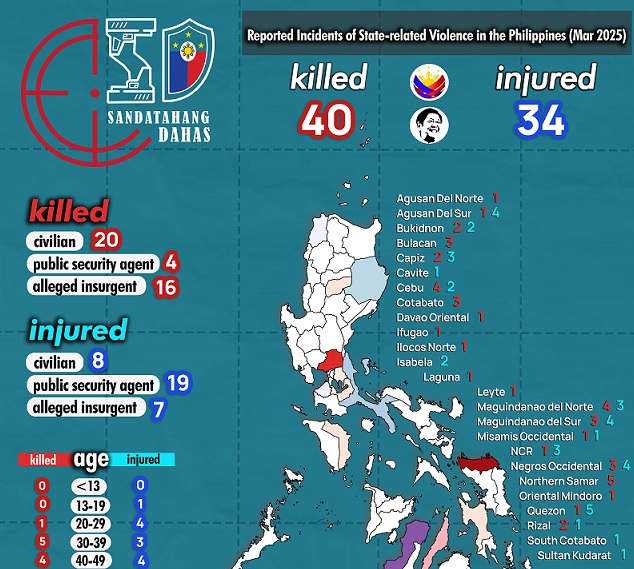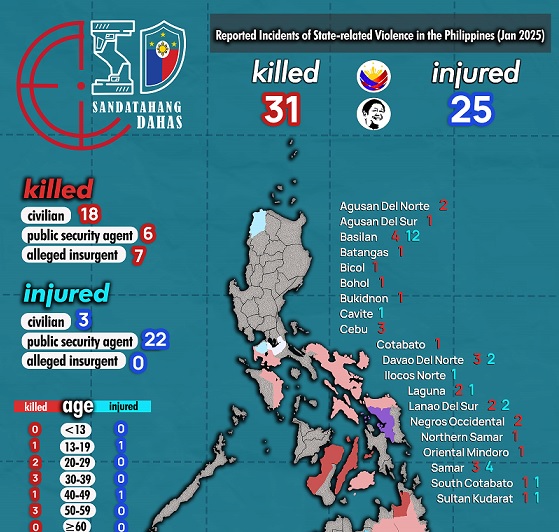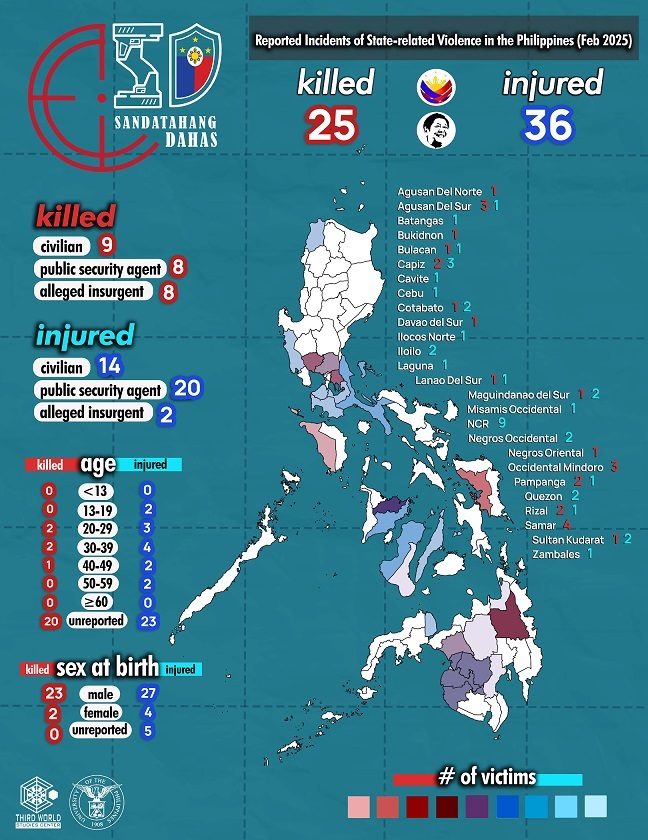Mindanao remains the epicenter of armed violence in the March 2025 Sandatahang Dahas’ mapping of state-related fatalities and injuries despite some areas previously considered by the government as low-risk or “insurgency-free.”
The total number of victims of state-related violence in March is 74: 40 killed, 34 injured. This is 21% higher than that of February (61) and 32% higher than that of January (56),
Mindanao accounts for 17 of the 40 killings and 15 of the 34 injuries.
in Bukidnon, which was recently celebrated by state authorities for having “insurgency-free” municipalities, two alleged insurgents were killed. This contradiction between official state declarations and lived realities casts doubt on the accuracy of such claims.
The case of Bukidnon demonstrates that declarations of peace are not guarantees of safety, especially when underlying militarized tensions remain unresolved.
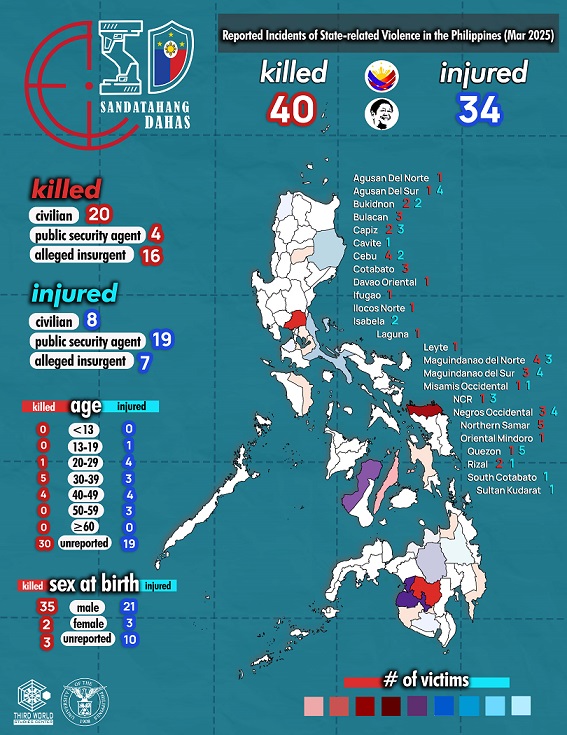
The monitor showed that the Armed Forces of the Philippines (AFP) was responsible for 18 killings: two civilians killed at checkpoints and 16 alleged insurgents killed during operations. Police officers were responsible for the deaths of 17 civilians engaged in various crimes: 11 killed during operations, three at checkpoints, and three in isolated incidents. The Philippine Drug Enforcement Agency (PDEA) had a death in custody.
Among the insurgents killed by the military were four alleged members of Dawlah Islamiya in Sitio Palao, Barangay Barira, Barira, Maguindanao del Norte. Mustapha “Abu Saiden” Kasan Kulaw, an alleged subleader of the DI-Hassan Group, along with three others, were killed in an encounter with the Marine Battalion Landing Team-2 (MBLT2) last March 17. Three unnamed Dawlah Islamiya members were also reported to have been injured during the clash. However, a relative of the victims disputed the account of the military that those who were killed and wounded were members of Dawlah Islamiya saying that they were just tending to the cows and horses in the field.
Related to deaths under questionable circumstances was those of Juan Amarilla Cantilla, a vegetable vendor, who was found dead while in the custody of the PDEA in Cebu City. He was reportedly arrested in a buy-bust operation, carrying 80 grams of shabu, and other drug paraphernalia. He committed suicide, the PDEA said.
As law enforcement agents used lethal force, they too were subjected to the same deadly assaults.
On March 8, in a drug operation in Bocaue, Bulacan, the armed suspect first shot SSg. Gian Dela Dela Cruz; he was brought to a hospital but later on died. SSg. Dennis Cudiamat, seeking to assist his colleague, ran after the suspect but was fatally shot in the head. The gunman has yet to be identified.
Also, in Bulacan, a soldier reportedly serving as a bodyguard was killed on the spot in an ambush by an unidentified armed group in San Rafael last March 21. The attack was believed to be politically motivated due to the upcoming elections.
A third case was that of a soldier and his brother shot by an unidentified gunman at a videoke bar in Butuan City on March 23. The incident occurred after the victim took the microphone away from the suspect when it was already the latter’s turn to sing. The commotion led to a fistfight before escalating to one of the brothers getting shot.
In March 2025, no law enforcement agent was killed by insurgents, unlike in the previous months.
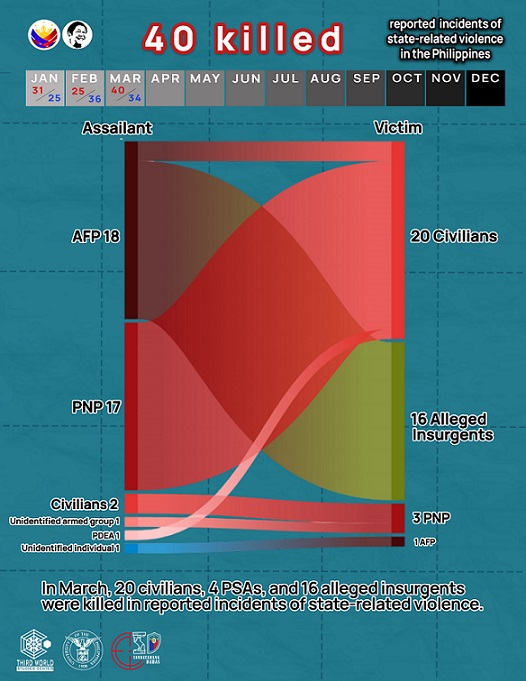
Of the 40 killed, 35 were reported to be male, two female, and three remain unreported.
As for injuries in state-related violence, mainly involving bodily harm, the Sandatahang Dahas monitor recorded 34 reported cases in March. Government security forces and civilians resisting police and military presence or operations were almost on equal measure responsible for the injuries.
Fifteen cases of injuries were linked to armed state personnel. The PNP leads this with eight victims and the AFP follows suit with seven. Meanwhile, civilians were responsible for 12 cases of injuries inflicted on law enforcement agents, with nine during operations, two at checkpoints, and one case of an attack against a member of the military.
Of these cases, the most prominent occurred on March 11 when former President Rodrigo Duterte was detained at Villamor Air due to a warrant of arrest issued by the International Criminal Court for his alleged crime against humanity. During the arrest, Honeylet Avanceña, Duterte’s common-law partner, smacked a soldier in the head with her mobile phone. The assault resulted in a large swollen lump on the soldier’s forehead. Avanceña was threatened with a direct assault charge. The police eventually decided not to pursue it.
Alleged insurgents inflicted harm on the police and the military in seven cases involving attacks on public security facilities and during armed encounters. In one case, alleged insurgents threw a grenade at a military post in Brgy. Madia, Datu Saudi Ampatuan, Maguindanao del Sur, injuring four soldiers. According to Lt. Col. Rosen Orbon, spokesman of the Army’s 6th Infantry Division, the attack was possibly carried out “out of frustration” at other rebels’ recent surrender to government authorities.
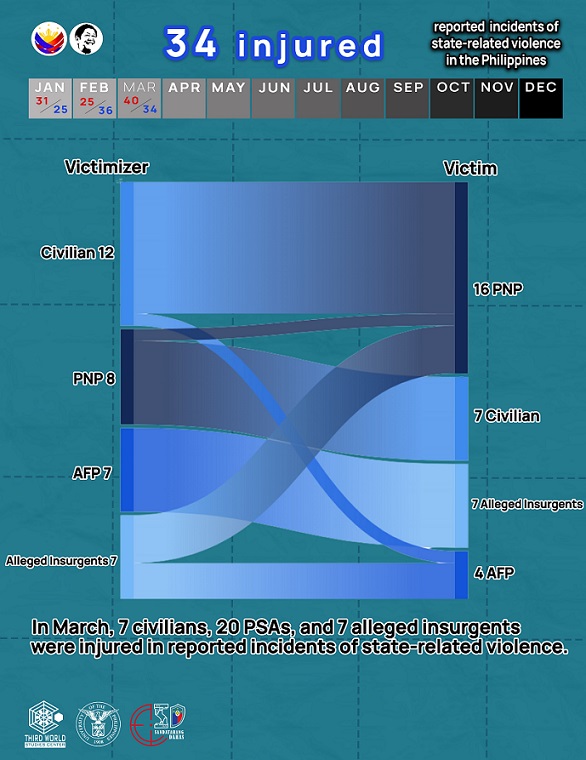
Of the 34 injuries, males also lead the number of cases with 21 recorded, followed by three females, and 10 unreported.
The Sandatahang Dahas monitor for March also recorded troubling incidents of evident abuse of authority, if not outright criminal acts, on the part of armed government personnel. Some of these violent incidents are now starting to appear as sustained repetitions of similar occurrences from the previous months.
A policeman in a road rage shooting killed a driver and wounded another person in Quezon City on March 20. The police officer has since been detained and will face murder and attempted murder charges.
In Cagayan de Oro, on March 24, a police master sergeant killed an alleged police asset who had previously filed a police blotter after receiving death threats. Authorities have yet to confirm a motive, though involvement in illegal drugs or personal grudges are being considered. On the same day, in the nearby town of Opol, a 16-year-old boy was reportedly beaten by three police officers after being suspected of being a gang member. While the Opol Police Station denied this allegation, the Provincial Women and Children Protection Unit of the Misamis Oriental Police Provincial Office (PPO) has launched an investigation into the matter.
On March 29 in Pasuquin, Ilocos Norte, a man trying to file a complaint in the police station was slapped and manhandled by three police officers. Part of the incident was recorded on a mobile phone and was widely shared in social media. The Ilocos Norte Police Provincial Office launched an investigation.
On another note, the Sandatahang Dahas monitor recorded for the fourth time this quarter an incident of a police killing or injuring another police officer or their partner with the motive rooted in more intimate or domestic circumstances.
On March 20, in Negros Occidental, a policeman shot dead his live-in partner, and later on himself, after a heated argument reported to be caused by jealousy. On March 24, in South Cotabato, a policewoman shot and critically wounded her policeman partner after he allegedly ignored the former’s rants on how her colleagues were mistreating her. This is similar to the February 3 incident in Angeles City where the wife, a police officer, shot dead her husband who was also in the police force. A week later, in Marawi City, two police women shot each other. One survived, one died. Jealousy was reported to be the motive that led to their fatal encounter.
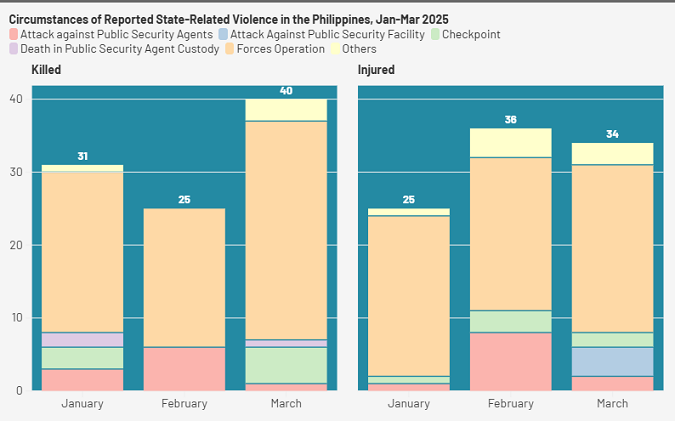
In Mindanao, the provinces of Maguindanao del Norte and Maguindanao del Sur report the highest casualties, with four killed and three injured in the former, and three killed and four injured in the latter. These figures hint at the enduring volatility of these areas, which were also major hotspots in February. Cotabato, Misamis Oriental, and Sultan Kudarat report at least one fatality each, consistent with the historical pattern of conflict between state forces and non-state actors, such as the ongoing battle between the AFP and the New People’s Army.
Luzon, on the other hand, records 10 killed and 13 injured, continuing the steep upward trajectory in violence that began in February. The National Capital Region alone accounts for one killed and three injured, while neighboring provinces such as Rizal, Quezon, and Bulacan contribute significantly to the tally. Rizal reports two killed and one injured, while Quezon has one killed and five injured—one of the highest injury counts in the country this month. Bulacan follows this trend with three killed. These provinces, characterized by dense populations, high economic activity, and increased political mobilization, make them potential hotspots during the early months of the election period. Other Luzon provinces such as Laguna and Oriental Mindoro report one killing each, while Ilocos Norte and Isabela report one and two injuries respectively.
Of particular significance this month is Ifugao, which has recorded its first case of state-related violence this year with one fatality. Ifugao has been largely insulated from the levels of conflict seen in other parts of the country.
In Visayas, violence appears more concentrated and persistent. A total of 13 were killed and six injured, with Cebu once again emerging as a major site of concern, reporting four killed and two injured. Negros Occidental continues its pattern of repeated violence, with three killed and four injured, sustaining the trend from both January and February, where it consistently appeared among the provinces with the most casualties. Other Visayan provinces such as Leyte and Northern Samar also report fatalities, with the latter accounting for five killed—the highest count for a single province this month. The situation in Samar provinces reflects long-standing insurgency-related violence, which shows no sign of abating given the government’s sustained anti-insurgency drive.
In comparing this month with the first two, March’s data further reinforces the idea that state-related violence in the Philippines is no longer geographically isolated; it is structural, adaptive, and capable of reaching places previously thought to be stable. As these violent encounters escalate, state narratives continue to frame these operations as part of a broader mission to preserve peace and order—a rhetoric steadily unraveled by the numbers, which tell a story not of peacekeeping, but of persistent, unabating violence.
The authors are interns at the Third World Studies Center, College of Social Sciences and Philosophy, University of the Philippines Diliman. To learn more about Sandatahang Dahas, visit its website: https://dahas.upd.edu.ph/sandatahang-dahas/ and for the latest updates, follow the Dahas Project in these social media platforms: https://x.com/DahasPH, https://www.instagram.com/dahas.project/, https://www.threads.net/@dahas.project, and https://bsky.app/profile/dahasph.bsky.social. Reports for the previous months are available at https://dahas.upd.edu.ph/sd-monthly-reports/.
